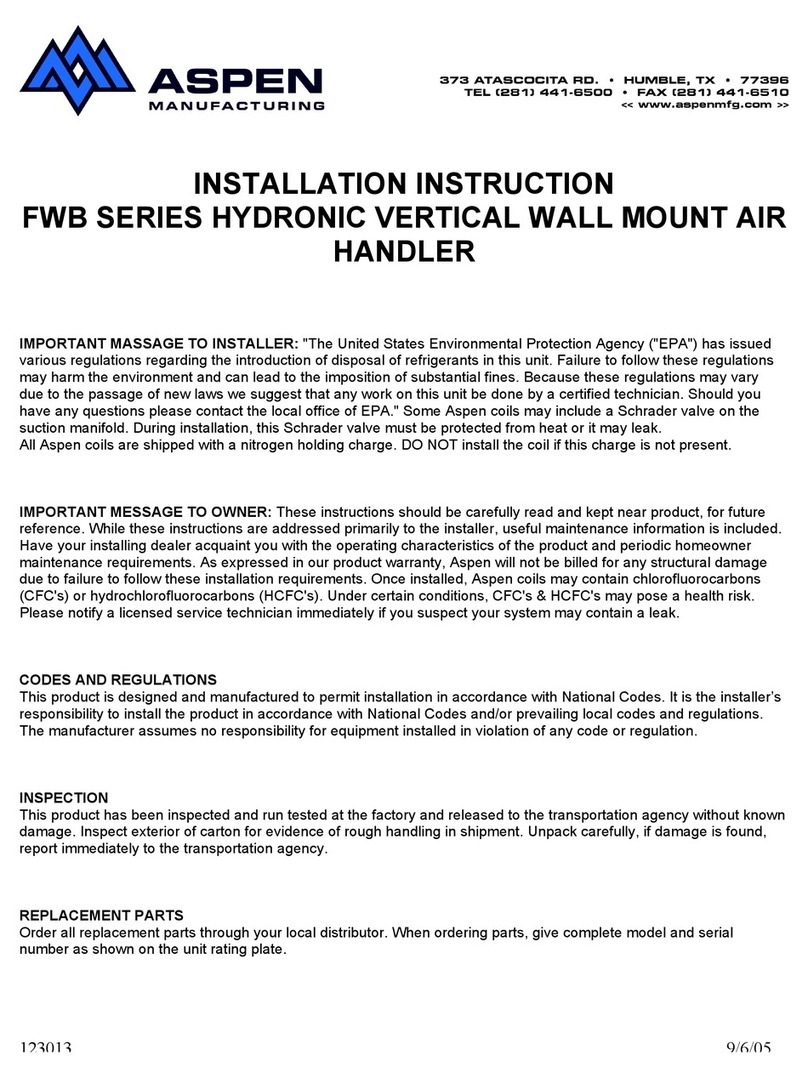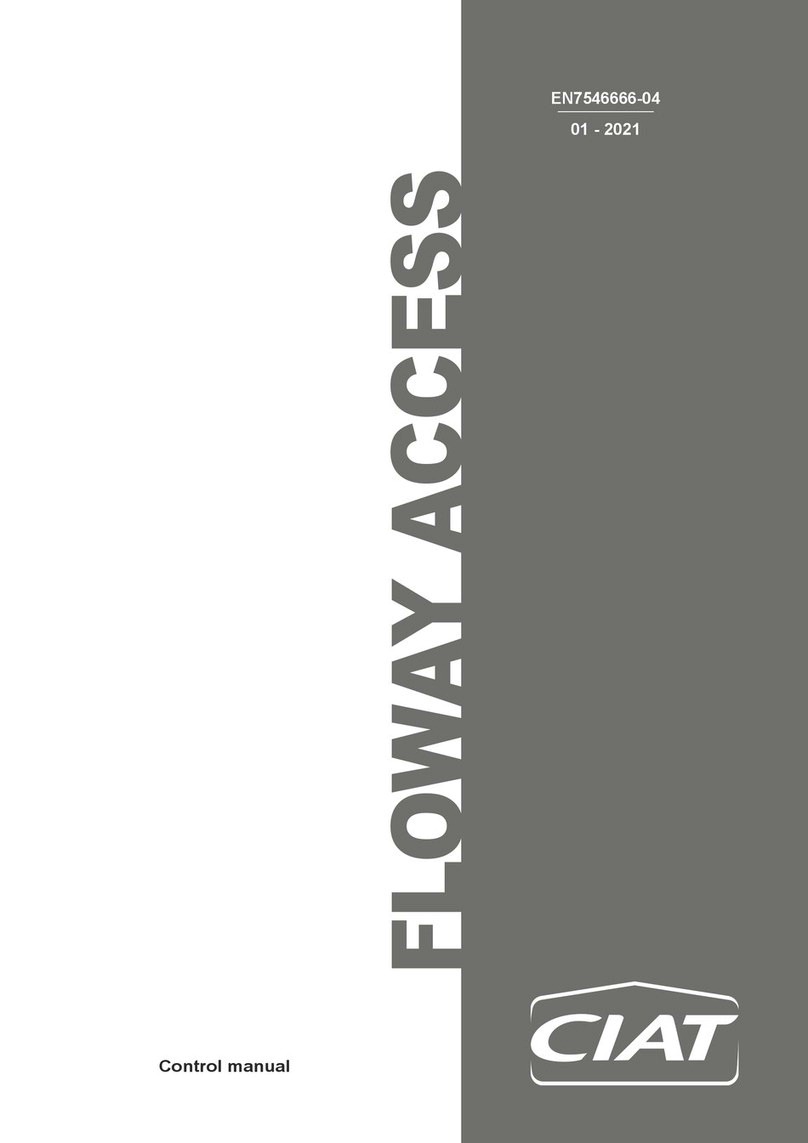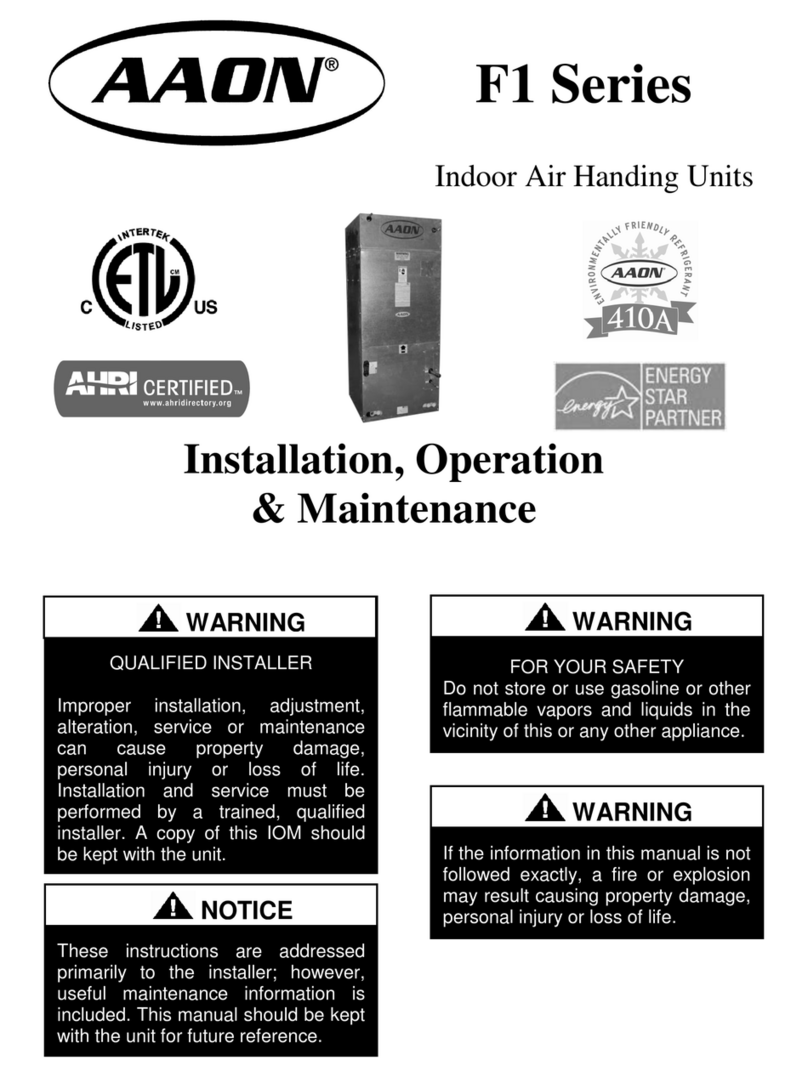KRUEGER KAH Operating manual

Krueger | 1401 N Plano Rd | Richardson, TX 75081 | 972.680.9136 | [email protected] | www.krueger-hvac.com
Model | KAH
Installation, Assembly, Start-up, and Service Instructions
OPERATION &
MAINTENANCE GUIDE

Krueger | 1401 N Plano Rd | Richardson, TX 75081 | 972.680.9136 | [email protected] | www.krueger-hvac.com
KAH Operation & Maintenance Guide
Page: 2 of 88
CHANGEABILITY OF THIS DOCUMENT
In complying with Krueger’s policy for continuous product improvement, the information contained in this document is
subject to change without notice. Krueger makes no commitment to update or provide current information automatically
to the manual owner. Updated manuals, if applicable, can be obtained by accessing the Krueger website at www.
krueger-hvac.com.
Operating/service personnel maintain responsibility for the applicability of these documents to the equipment. If there
is any question regarding the applicability of these documents, the technician should verify whether the equipment has
been modied and if current literature is available from the owner of the equipment prior to performing any work on the
chiller.
CHANGE BARS
Revisions made to this document are indicated with a line along the left or right hand column in the area the revision
was made. These revisions are to technical information and any other changes in spelling, grammar or formatting are
not included.

KAH Operation & Maintenance Guide
Page: 3 of 88
Krueger | 1401 N Plano Rd | Richardson, TX 75081 | 972.680.9136 | [email protected] | www.krueger-hvac.com
General Safety Guidelines & Safety Symbols
Section 1: General Information & Safety
Section 2: Start-up & Operation
Before Start-up, Checking Operation of Dampers --
Air Measuring --
AMS-60 Damper --
Outside Air and Exhaust Air Dampers, Energize Fan Motors --
Variable Frequency Drive (VFD), Check Doors & Latches, Energy Recovery Wheel --
Pre-Start-up Checklist --
Operation, Test & Balance --
Setting Limits, Checking Motors, Belts and Sheaves --
Section 3: Maintenance
General Requirements --
Inspect Parts, Fan Segment, Operating Adjustable Motor Base --
Checking Belt Tension --
Aligning Sheaves --
Belt Replacement Tensioning & Sheave Alignment for Top Mount --
Lubrication --
UVC Emitter Lamps --
Maintaining and Replacing Filter Segments --
Economizer Segment (Dampers), Coil Segment Cleaning --
Condensate Drain Pan, Trap and Line Cleaning --
Energy Recovery Wheel --
Section 4: Service & Repair
Service Tools and Equipment --
Service Information, Troubleshooting --
Pitot Tube, Inlined Manometer, Minihelic Filter Gauge --
U-Tube Manometer --
Duct Pressures --
Adjusting, Removing, and Installing Sheaves --
Requesting Assistance --
Section 5: Wiring Diagrams
Section 6: Conversions & Temperature
4
5
6
6
11
12
15
16
23
34
35
36
36
37
39
40
41
42
47
48
49
50
51
59
59
60
61
62
63
64
68
69
84
TABLE OF CONTENTS

Krueger | 1401 N Plano Rd | Richardson, TX 75081 | 972.680.9136 | [email protected] | www.krueger-hvac.com
KAH Operation & Maintenance Guide
Page: 4 of 88
GENERAL SAFETY GUIDELINES
This equipment is a relatively complicated apparatus. During installation, operation maintenance or service, individuals
may be exposed to certain components or conditions including, but not limited to: refrigerants, UV, materials under
pressure, rotating components, and both high and low voltage. Each of these items has the potential, if misused or
handled improperly, to cause bodily injury or death. It is the obligation and responsibility of operating/service personnel
to identify and recognize these inherent hazards, protect themselves, and proceed safely in completing their tasks.
Failure to comply with any of these requirements could result in serious damage to the equipment and the property in
which it is situated, as well as severe personal injury or death to themselves and people at the site.
This document is intended for use by owner-authorized operating/service personnel. It is expected that these individuals
possess independent training that will enable them to perform their assigned tasks properly and safely. It is essential
that, prior to performing any task on this equipment, this individual shall have read and understood this document
and any referenced materials. This individual shall also be familiar with and comply with all applicable governmental
standards and regulations pertaining to the task in question.
IMPORTANT!
READ BEFORE PROCEEDING!
SAFETY SYMBOLS
The following symbols are used in this document to alert the reader to specic situations:
NOTE - Highlights additional information useful to the technician in completing the work being performed
properly.
CAUTION - Identies a hazard which could lead to damage to the machine, damage to other equipment and/or
environmental pollution if proper care is not taken or instructions and are not followed.
DANGER - Indicates a possible hazardous situation which will result in death or serious injury if proper care is
not taken.
WARNING - Indicates a potentially hazardous situation which will result in possible injuries or damage to
equipment if proper care is not taken.
WARNING - External wiring, unless specied as an optional connection in the manufacturer’s product line, is
not to be connected inside the control cabinet. Devices such as relays, switches, transducers and controls and
any external wiring must not be installed inside the micro panel. All wiring must be in accordance with Krueger’
published specications and must be performed only by a qualied electrician. Krueger will NOT be responsible
for damage/problems resulting from improper connections to the controls or application of improper control
signals. Failure to follow this warning will void the manufacturer’s warranty and cause serious damage to
property or personal injury.

KAH Operation & Maintenance Guide
Page: 5 of 88
Krueger | 1401 N Plano Rd | Richardson, TX 75081 | 972.680.9136 | [email protected] | www.krueger-hvac.com
INTRODUCTION
Krueger’s air handling unit (AHU) is manufactured to the
highest design and construction standards to ensure high
performance, reliability and adaptability to all types of air
handling installations.
ABOUT THIS MANUAL
This manual and any other document supplied with the
AHU are the property of Krueger, which reserves all rights.
This manual may not be reproduced, in whole or in part,
without prior written authorization from an authorized
Krueger representative.
In addition, this manual:
• Includes suggested best working practices and
procedures, which are issued for guidance only,
and they do not take precedence over the above
stated individual responsibility and/or local safety
regulations.
• Contains all the information required for correct
installation and commissioning of the AHU, together
with operating and maintenance instructions.
• Should be read thoroughly before attempting to
operate or service the AHU.
• Contains detailed procedures, including installation,
commissioning and maintenance tasks that must
only be performed by suitably trained and qualied
personnel.
The manufacturer will not be liable for any injury or
damage caused by incorrect installation, commissioning,
operation, or maintenance resulting from a failure to follow
the procedures and instructions detailed in the manual.
RESPONSIBILITY FOR SAFETY
Every care has been taken in the design and manufacture
of the AHU to ensure compliance with the safety
requirements. However, the individual operating or working
on any equipment is primarily responsible for:
• Personal safety, safety of other personnel, and the
equipment.
• Correct utilization of the equipment in accordance
with the procedures detailed in this manual.
WARRANTY
Krueger warrants AHU products (model KAH) in
accordance with the limited warranty engineered systems
equipment procedure. Refer to the Limited Warranty for
more information.
Krueger warrants all equipment and materials against
defects in workmanship and materials for a period of 18
months from the date of shipment or 12 months from the
date of start-up, whichever comes rst.
The warranty is limited to parts only replacement and
shipping of any faulty part or subassembly, which has
failed due to defects in workmanship and materials. All
claims must be supported by evidence that the failure has
occurred within the warranty period, and that the AHU was
operated within the designed parameters specied.
All warranty claims must specify the AHU model, serial
number, order number, and run hours/starts. Model
and serial number information is printed on the AHU
identication plate.
The AHU warranty will be void if any modication to the
AHU is carried out without prior written approval from
Krueger. For warranty purposes, the following conditions
must be satised:
• Only genuine Krueger approved spare parts must be
used.
• All of the scheduled maintenance operations detailed
in this manual must be performed at the specied
times by suitably trained and qualied personnel.
• Failure to satisfy any of these conditions will
automatically void the warranty. Refer to the Limited
Warranty for details.
SECTION 1 - GENERAL INFORMATION & SAFETY

Krueger | 1401 N Plano Rd | Richardson, TX 75081 | 972.680.9136 | [email protected] | www.krueger-hvac.com
KAH Operation & Maintenance Guide
Page: 6 of 88
BEFORE START-UP
Perform a general inspection. Identify and perform the appropriate the
lock out/tag out and safety rules. Refer to the AHU Start-up Checklist
provided with the information package shipped with the AHU.
For more information about the steps below, refer to the AHU
Installation Guide. For an AHU equipped with a Variable Frequency
Drive (VFD), refer to the specic VFD literature for additional start-up
requirements.
• Check for damage to the AHU’s interior and exterior.
• Ensure the terminal screws and wiring connections are secure in
the control, electric and air modulator panels.
• Verify that the:
»Equipment was received as ordered.
»AHU was installed on at and level surface and with proper
clearances.
»Condensate drains are properly trapped.
»All wiring and tubing connections are complete at shipping
splits.
»All eld piping connections are completed.
»All shipped loose parts are installed.
»All ductwork is complete and available for full airow.
»Installer removed all dirt, debris, hardware, mold, etc. from
interior of the AHU and its ducts.
»Filter gauge is set to zero.
»All shipping splits are sealed and secured properly.
»All shipping bolts and other materials were removed.
• Ensure clean air lters are installed and secured properly.
• Inspect all eld provided wiring completely.
• Do not remove the functional bolts from the seismic isolators as
shown in Figure 1 (right).
• Ensure the damper linkage is tight and is in the correct power
off position.
• If the return air dampers are closed, loosen the actuator or crank
arm on the jackshaft, open the dampers, and re-tighten the
actuator or crank arm.
• Verify the following controls installation are complete:
»Contractor Furnished Controls - Controls contractor is
responsible for safe and proper control of the AHU.
SECTION 2 - START-UP & OPERATION
FIGURE 1 - SEISMIC ISOLATOR
NOTE - Do not remove the shipping
bolts if there are no springs.
NOTE - Never use silicone caulk/sealant or caulk/sealant
containing silicone in or on any air handling equipment.
Inspecting Fan Assembly
Use the following instructions to inspect the
fan assembly.
1. When the AHU is removed from long
term storage, purge the moisture-laden
bearing grease, and replenish the AHU
with fresh grease, according to the
lubrication label.
2. Meg the motor to verify that the resistance
is at a satisfactory level, compared to the
value recorded prior to storage.
3. Check the torque for bearings and locking
collars as shown in Table 1 on the next
page.
4. Verify that the fan wheel is properly
aligned, is tight on the shaft, and moves
freely.
5. Make sure the fan bearings are properly
lubricated. Refer to SECTION 3 -
MAINTENANCE in this manual for more
information.
6. Verify that the tie down bolts are removed
from the four corners of the fan base
assembly as shown in Figure 2 on the
next page. For small AHUs, the tie down
bolts may only be applied to three corners
of the fan base since one corner is not
accessible.

KAH Operation & Maintenance Guide
Page: 7 of 88
Krueger | 1401 N Plano Rd | Richardson, TX 75081 | 972.680.9136 | [email protected] | www.krueger-hvac.com
Inspecting Belts and Sheaves
1. Verify that the sheaves are properly aligned and tight
on the shaft. Improper sheave alignment and belt
tension are potential causes of excessive noise and
vibration, and shortened belt and bearing life. Refer
to SECTION 3 - MAINTENANCE in this manual for
more information.
2. Check the belt tension. If not familiar with the process,
refer to SECTION 3 - MAINTENANCE in this manual.
It is normal for belts to loosen after start-up. The new
belts will run in or take a set by seating slightly deeper
into the grooves of the sheaves. Recheck the tension
after one day, and three days.
3. Make sure the motor mounting bolts and adjustable
motor base bolts are tight.
Checking Isolators
Check the fan base isolators and thrust restraints for
proper adjustment.
• Standard fan isolation consists of spring isolators as
shown in Figure 3 (right) mounted under the internal
fan assembly.
• For thrust restraint adjustment procedures, if
applicable, refer to the service manual.
• Prepare the fan isolators for operation, using the
following instructions:
1. After removing the tie down bolts from the
internal fan assembly, check the blower/motor
frame for the correct height, and that the frame
is level.
2. To adjust the isolators as shown in Figure 3
(right).
a. Loosen the cap screws on top of the
adjustment bolt.
b. Turn the adjusting bolt.
c. Check the operational height and level of
the frame. Repeat this procedure until the
height and frame are level.
d. Tighten the cap screws. Refer to the
service manual for additional instructions.
• Verify the fan is aligned with the AHU discharge.
• Readjust the isolators as necessary.
SECTION 2 - START-UP & OPERATION (CONTINUED)
FIGURE 2 - FAN & MOTOR ISOLATOR SUPPORT FRAME
Tie Down Bolts
FIGURE 3 - SPRING ISOLATOR
SETSCREW
DIAMETER
(IN)
HEX SIZE
ACROSS
FLATS (IN)
MINIMUM
RECOMMENDED TORQUE
IN LB FT LB
1/4 1/8 66 - 85 5.5 - 7.08
5/16 5/32 126 - 164 10.5 - 13.7
3/8 3/16 228 - 296 19.0 - 24.7
7/16 7/32 348 - 452 29.0 - 35.7
1/2 1/4 504 - 655 42.0 - 54.6
5/8 5/16 1104 - 1435 92.0 - 119.6
TABLE 1 - TORQUE FOR TIGHTENING SET SCREWS

Krueger | 1401 N Plano Rd | Richardson, TX 75081 | 972.680.9136 | [email protected] | www.krueger-hvac.com
KAH Operation & Maintenance Guide
Page: 8 of 88
START-UP
It is recommended that the start-up technician use the
AHU Start-up Checklist, included with the AHU, and record
the gathered information in the appropriate elds. If there
are questions, refer to Table 15 on page 58 for inspection
requirements.
Install the provided or temporary lter media prior to start-
up to adequately protect the components in the air stream
and duct system.
If the AHU is equipped with an energy recovery wheel,
rotate the wheel when the AHU is in service to prevent
clogging.
Checking Operation of Fans
Check of the operation of the fans by:
1. Verifying the correct voltage, phase and cycles.
2. Energizing the power to the AHU disconnect switch.
3. Energizing the fan motor(s), briey (bump) and check
for correct fan rotation.
If the fan rotation is incorrect:
1. On three-phase equipment, reverse any two motor
leads at the load side of the last starter component.
2. On single-phase equipment, follow the wiring diagram
on the motor housing or on the inside of the motor
terminal box.
3. Recheck for correct fan rotation.
SECTION 2 - START-UP & OPERATION (CONTINUED)
FIGURE 4 - COUNTERBALANCE LOCKED INTO
PLACE FOR SHIPPING
FIGURE 5 - COUNTERBALANCE UNLOCKED FOR
START-UP
CAUTION - Do not be operate this AHU until
after start-up is completed as outlined in these
instructions. Do not allow the AHU to run on
unreliable temporary power, which could turn the
AHU on/off periodically or rapidly, and to protect
it from irregular voltages and surges.
CAUTION - Most units are shipped with dampers
in closed position. Release and adjustment is to
be done by eld technician only.
Back Draft Dampers for Dual Fans
The counterbalance is locked into place for shipping
as shown in Figure 5 on page 18. Before startup, the
counterbalance will have to be released. To do this, loosen
the set screws and slide the counterbalance off the end
of the shaft. Flip the counterbalance and slide it back on
the shaft. Rotate the counterbalance above the damper
as shown in Figure 6 on page 18, and then tighten the set
screws. The counterbalance should be free to rotate.
Checking Operation of Dampers
Make sure the AHU will not operate with all dampers
closed.
Linkage design and/or damper linkage is optional. Airow
control dampers may be operated with pneumatic or
electric actuator/controllers.
Prior to occupancy, test the ventilation system to
ensure that the outdoor air dampers operate properly in
accordance with the system design.

KAH Operation & Maintenance Guide
Page: 9 of 88
Krueger | 1401 N Plano Rd | Richardson, TX 75081 | 972.680.9136 | [email protected] | www.krueger-hvac.com
SECTION 2 - START-UP & OPERATION (CONTINUED)
FAN
TYPE
FAN
CLASS
FAN
SIZE K N FAN
TYPE
FAN
CLASS
FAN
SIZE K N FAN
TYPE
FAN
CLASS
FAN
SIZE K N
ATLI 2 7X7 3675.20 0.5064 ATZAF 1 12X12 2337.50 N/A EPFN 2 222 2713.93 N/A
ATLI 2 9X6 3919.00 0.5534 ATZAF 2 12X12 2237.30 N/A EPFN 3 222 2713.93 N/A
ATLI 2 9X9 5510.60 0.4857 ATZAF 1 15X15 3873.60 N/A EPFN 1 245 3285.02 N/A
ATLI 2 10X7 5556.20 0.4950 ATZAF 2 15X15 3873.60 N/A EPFN 2 245 3285.02 N/A
ATLI 2 10X10 5556.20 0.4950 ATZAF 1 18X18 4675.00 N/A EPFN 3 245 3285.02 N/A
ATLI 2 12X9 6789.70 0.4654 ATZAF 2 18X18 4675.00 N/A EPFN 1 270 3997.61 N/A
ATLI 2 12X12 8190.10 0.4887 ATZAF 1 20X20 5843.70 N/A EPFN 2 270 3997.61 N/A
ATLI 2 15X11 11065.00 0.4800 ATZAF 2 20X20 5301.10 N/A EPFN 3 270 3997.61 N/A
ATLI 2 15X15 11065.00 0.4800 ATZAF 1 22X22 7513.40 N/A EPFN 1 300 4945.21 N/A
ATLI 2 18X13 11610.00 0.4670 ATZAF 2 22X22 6624.10 N/A EPFN 2 300 4945.21 N/A
ATLI 2 18X18 13101.80 0.4754 ATZAF 1 25X25 9683.90 N/A EPFN 3 300 4945.21 N/A
ATLI 1 20X15 7013.10 N/A ATZAF 2 25X25 9202.90 N/A EPFN 1 330 5968.62 N/A
ATLI 1 20X20 7300.00 N/A ATZAF 1 28X28 12856.20 N/A EPFN 2 330 5968.62 N/A
ATLI 1 22X22 9081.90 N/A ATZAF 2 28X28 11795.00 N/A EPFN 3 330 5968.62 N/A
ATLI 1 25X25 12030.00 N/A ATZAF 1 32X32 16295.60 N/A EPFN 1 365 7290.21 N/A
ATLI 1 28X28 14450.00 N/A ATZAF 2 32X32 16295.60 N/A EPFN 2 365 7290.21 N/A
ATLI 1 32X32 20400.00 N/A ATZAF 1 36X36 19701.70 N/A EPFN 3 365 7290.21 N/A
ATLI 1 36X36 28049.90 N/A ATZAF 2 36X36 19367.80 N/A EPFN 1 402 8869.55 N/A
ATLI 1 40X40 39236.40 N/A ATZAF 1 40X40 23374.90 N/A EPFN 2 402 8869.55 N/A
ATLI R 7X7 2200.70 0.4952 ATZAF 1 40X40 25378.40 N/A EPFN 3 402 8869.55 N/A
ATLI R 9X6 2759.60 0.5155 ATZAF 2 40X40 22974.20 N/A EPFN 1 445 10827.92 N/A
ATLI R 9X9 2805.50 0.4783 ATZAF 2 40X40 25044.50 N/A EPFN 2 445 10827.92 N/A
ATLI R 10X7 4052.20 0.5091 EPFN 1 122 944.92 N/A EPFN 3 445 10827.92 N/A
ATLI R 10X10 3862.70 0.4658 EPFN 2 122 944.92 N/A EPFN 1 490 13135.01 N/A
ATLI R 12X9 5497.20 0.4996 EPFN 3 122 944.92 N/A EPFN 2 490 13135.01 N/A
ATLI R 12X12 5477.90 0.4496 EPFN 1 150 1206.40 N/A EPFN 3 490 13135.01 N/A
ATLI R 15X11 7684.90 0.5195 EPFN 2 150 1206.40 N/A EPFN 1 542 16111.75 N/A
ATLI R 15X15 7684.90 0.5195 EPFN 3 150 1206.40 N/A EPFN 2 542 16111.75 N/A
ATLI R 18X13 14222.00 0.5236 EPFN 1 165 1518.58 N/A EPFN 3 542 16111.75 N/A
ATLI R 18X18 11510.00 0.4763 EPFN 2 165 1518.58 N/A EPLFN 2 122 944.92 N/A
ATLI 2 20X15 6809.40 N/A EPFN 3 165 1518.58 N/A EPLFN 2 150 1206.40 N/A
ATLI 2 20X20 7203.90 N/A EPFN 1 182 1821.92 N/A EPLFN 2 165 1518.58 N/A
ATLI 2 22X22 8793.10 N/A EPFN 2 182 1821.92 N/A EPLFN 2 182 1821.92 N/A
ATLI 2 25X25 11700.00 N/A EPFN 3 182 1821.92 N/A EPLFN 2 200 2185.80 N/A
ATLI 2 28X28 14036.00 N/A EPFN 1 200 2185.80 N/A EPLFN 2 222 2713.93 N/A
ATLI 2 32X32 2015.00 N/A EPFN 2 200 2185.80 N/A EPLFN 2 245 3285.02 N/A
ATLI 2 36X36 27549.00 N/A EPFN 3 200 2185.80 N/A EPLFN 2 270 3997.61 N/A
ATLI 2 40X40 38067.70 N/A EPFN 1 222 2713.93 N/A EPLFN 2 300 4945.21 N/A
TABLE 2 - AIR MEASURING DEVICE CONNECTIONS

Krueger | 1401 N Plano Rd | Richardson, TX 75081 | 972.680.9136 | [email protected] | www.krueger-hvac.com
KAH Operation & Maintenance Guide
Page: 10 of 88
SECTION 2 - START-UP & OPERATION (CONTINUED)
FAN TYPE FAN CLASS FAN SIZE K N FAN TYPE FAN CLASS FAN SIZE K N
EPLFN 2 330 5968.62 N/A MPQS 1 122 944.92 N/A
EPLFN 2 365 7290.21 N/A MPQS 2 122 944.92 N/A
EPLFN 2 402 8869.55 N/A MPQS 3 122 944.92 N/A
EPLFN 2 445 10827.92 N/A MPQS 1 150 1206.40 N/A
EPLFN 2 490 13135.01 N/A MPQS 2 150 1206.40 N/A
MPQN 1 122 944.92 N/A MPQS 3 150 1206.40 N/A
MPQN 2 122 944.92 N/A MPQS 1 165 1518.58 N/A
MPQN 3 122 944.92 N/A MPQS 2 165 1518.58 N/A
MPQN 1 150 1206.40 N/A MPQS 3 165 1518.58 N/A
MPQN 2 150 1206.40 N/A MPQS 1 182 1821.92 N/A
MPQN 3 150 1206.40 N/A MPQS 2 182 1821.92 N/A
MPQN 1 165 1518.58 N/A MPQS 3 182 1821.92 N/A
MPQN 2 165 1518.58 N/A MPQS 1 200 2185.80 N/A
MPQN 3 165 1518.58 N/A MPQS 2 200 2185.80 N/A
MPQN 1 182 1821.92 N/A MPQS 3 200 2185.80 N/A
MPQN 2 182 1821.92 N/A MPQS 1 222 2713.93 N/A
MPQN 3 182 1821.92 N/A MPQS 2 222 2713.93 N/A
MPQN 1 200 2185.80 N/A MPQS 3 222 2713.93 N/A
MPQN 2 200 2185.80 N/A MPQS 1 245 3285.02 N/A
MPQN 3 200 2185.80 N/A MPQS 2 245 3285.02 N/A
MPQN 1 222 2713.93 N/A MPQS 3 245 3285.02 N/A
MPQN 2 222 2713.93 N/A MPQS 1 270 3997.61 N/A
MPQN 3 222 2713.93 N/A MPQS 2 270 3997.61 N/A
MPQN 1 245 3285.02 N/A MPQS 3 270 3997.61 N/A
MPQN 2 245 3285.02 N/A MPQS 1 300 4945.21 N/A
MPQN 3 245 3285.02 N/A MPQS 2 300 4945.21 N/A
MPQN 1 270 3997.61 N/A MPQS 3 300 4945.21 N/A
MPQN 2 270 3997.61 N/A
MPQN 3 270 3997.61 N/A
MPQN 1 300 4945.21 N/A
MPQN 2 300 4945.21 N/A
MPQN 3 300 4945.21 N/A
MPQN 1 330 5968.62 N/A
TABLE 2 - AIR MEASURING DEVICE CONNECTIONS (CONTINUED)

KAH Operation & Maintenance Guide
Page: 11 of 88
Krueger | 1401 N Plano Rd | Richardson, TX 75081 | 972.680.9136 | [email protected] | www.krueger-hvac.com
SECTION 2 - START-UP & OPERATION (CONTINUED)
Air Measuring at the Fan Inlets
• COMETER is a probe attached to the fan bearing
support on Comefri Forward Curve fans from size 7 x
7 up to 18 x 18. The probe is located on the outboard
side of the housed fan assembly. The probe is piped to
the negative (-) port of a factory mounted transducer
on the fan wall. The positive (+) port is left open to the
fan section. Wiring is not provided to the transducer.
• PIEZORING (PIEZOMETER) is a tting or series of
ttings in the inlet cone(s) of housed fans larger than
18 x 18 and all sizes of Plenum fans that are combined
into a single connection piped to the negative (-) port
of a factory mounted transducer on the fan wall. The
positive (+) port is left open to the fan section. Wiring
is not provided to the transducer.
NOTE - The fan manufacturer does not recommend
placement of the ow measuring probes inside
the fan inlet cone in the path of airow. These
devices create disturbances and unpredictable
performance losses.
FIGURE 6 - HIGH AND LOW CONNECTIONS FOR AN
IN FAN AIR MONITORING SYSTEM
FIGURE 7 - PORT LOCATIONS FOR FAN MOUNTED
AIR MONITORING SYSTEM
High Port
Low Port
Air Measuring at Unit Outside Air Inlets
• AMS-60 used on indoor air handlers usually measure
outside air. This can be provided with one or two pairs
of positive (+ or High) and negative (- or Low) pressure
tube connections. Connect (+) and (-) respectively to
the (+) and (-) ports of the transducer(s). Wiring and
transducer are not provided unless factory packaged
controls were selected.
Airow Control Dampers
Many combinations of damper sizes are available to
control the ow. Mixing the return and outside air in the
AHU’s air inlet section may be supplied as follows:
• 100% outside air, 100% return air.
• 100% outside air, 0% return air.
• 0% outside air, 100% return air.
• Economizer section - 100% outside air, 100% return
air, 100% exhaust air or mixed air.
Check the dampers, actuators, controls and linkage prior
to applying power to the operators, to make sure nothing
will obstruct the operation of the dampers.
Return air dampers may be closed for shipping. Loosen
the actuator or crank arm on the jackshaft, open the
dampers, and re-tighten the actuator or crank arm. The
eld is responsible for adjustments.
Air Measuring Device Connections
Calculating Flow Rate
For a Piezoring:
CFM = k * √ΔP
ΔP = The differential in static pressure across the fan (in. w.g.)
k = See the following table
This assumes a standard air density of .075 lbs / cubic foot at
sea level.
For a Cometer:
CFM = k * √ΔPn
ΔP = The differential in static pressure across the fan (in. w.g.)
k = See the following table
n = See the following table
This assumes a standard air density of .075 lbs / cubic foot at
sea level.
NOTE - Do not overdrive the damper actuators
because this may damage the dampers.
Exception: Actuators with over drive preset option.

Krueger | 1401 N Plano Rd | Richardson, TX 75081 | 972.680.9136 | [email protected] | www.krueger-hvac.com
KAH Operation & Maintenance Guide
Page: 12 of 88
SECTION 2 - START-UP & OPERATION (CONTINUED)
AMS-60 Damper
General
The AMS-60 is an airow monitoring device which
combines the functions of control damper and airow
measurement station into one assembly. It is ideally suited
for factory installation in Solution air handling units. The
AMS-60 is tested to AMCA Standard 611-95 and qualies
to bear the AMCA Ratings Seal for Airow Measurement
Performance.
Damper Operation
The AMS-60 airow monitoring damper design incorporates
a low leakage control damper with stationary, vertical air
monitoring blades and air straightening section into one
assembly. The control damper utilized for modulating airow
is the ultra-low leak Ruskin CD-60 with its standard blade
and jamb seals used for low leakage. Strategically placed
stationary and vertical airow sensing blades measure the
air stream velocity pressure. Air tubing/piping connections
are provided to connect the sensing blades to an optional
factory-mounted transducer. The transducer converts the
velocity pressure from the sensing blades to an electrical
output signal for the Building Automation System (BAS).
The output signal corresponds directly to ow through the
damper. The BAS compares this signal to the design CFM
setpoint as determined by the particular mode of operation
of the HVAC system. In normal operation, this setpoint
corresponds to the minimum outside air ventilation required
by the system design to meet ASHRAE Standard 62.
Based on the difference between the actual CFM reading
and the desired setpoint, the BAS would send a signal to
the optional, factory-mounted control damper Actuator to
position the damper blades as necessary to ensure that
the actual outside airow meets the desired level.
FIGURE 8 - DUCTWORK INLET REQUIREMENTS
D
W
H
Mixing Box
FIGURE 9 - DUCTWORK RADIUS
Mixing Box
R
W
No Calibration Required
The AMS-60 airow monitoring damper is factory
calibrated. Calibration is not required at the jobsite.
Ductwork Inlet Requirements
When connecting the ductwork to a mixing box with an
AMS-60 damper, a minimum of one (1) equivalent duct
diameter of straight duct is required before entering the
AMS-60 damper.
1 Equivalent Duct Diameter = d
If one equivalent duct diameter cannot be achieved during
installation, the rectangular elbow may be substituted with
a radius elbow. The outside radius must have a R/W ratio
of 0.75 or more.
Damper Linkage Arrangements
The AMS-60 mixing box will ship with independent return
air and outside air damper actuators if selected in the MB
or FM segments.

KAH Operation & Maintenance Guide
Page: 13 of 88
Krueger | 1401 N Plano Rd | Richardson, TX 75081 | 972.680.9136 | [email protected] | www.krueger-hvac.com
SECTION 2 - START-UP & OPERATION (CONTINUED)
Damper Congurations
There are 3 possible damper congurations, 25% Sensing
option (Min./Max.), 25% / 75% Sensing option, and 100%
Sensing option.
25% Sensing Option (Min./Max.)
The 25% Sensing (Min./Max.) option arrangement is a
dual damper design and used for measuring the minimum
outside air requirement. In this arrangement, the 25%
damper would be for monitoring airow through the rst
25% down to 3.75% nominal ow and the 75% damper
would have a separate actuator and used for economizer
control only.
This option would be the best low cost option for areas in
which economizer cycles are not often seen, such as the
southeast, and are required to constantly operate in at the
minimum outside air position.
25% / 75% Sensing Option
The 25 / 75% Sensing option arrangement is similar to the
25% Sensing (Min./Max.) option, but also allows you to
measure airow throughout the economizer cycle. In this
arrangement, the 25% damper would be for monitoring
nominal airow through the rst 25% down to 3.75% and
the 75% damper would be for monitoring the remaining
75%.
100% Sensing Option
The 100% sensing arrangement is a single damper design
used to measure airow throughout the full range of the
outside air damper down to 15% of nominal airow.
The 100% sensing option is the lowest cost option, but
should not be utilized when minimum airow to be sensed
falls below 15% nominal ow. The 25% Sensing (Min./
Max.) and 100% Sensing option arrangements will be the
most prevalent.
The 100% Sensing arrangement with the outside and
return air dampers tied to a common actuator, will usually
be the most common conguration and cost-effective
solution. However, areas in which economizer cycles
are not often seen and operate primarily in minimum
outside air position, the 25% Sensing option should be the
preferred option for lowest airow monitoring and a cost-
effective solution.
In each of the available congurations, the minimum
airow across the sensing portion of the airow monitoring
station is 300 FPM for the KAH unit.
FIGURE 10 - 25% SENSING OPTION
FIGURE 11 - 25% / 75% SENSING OPTION
FIGURE 12 - 25% / 75% SENSING OPTION

Krueger | 1401 N Plano Rd | Richardson, TX 75081 | 972.680.9136 | [email protected] | www.krueger-hvac.com
KAH Operation & Maintenance Guide
Page: 14 of 88
SECTION 2 - START-UP & OPERATION (CONTINUED)
Jumper Selections
When selected, the AMS-60 factory provided transducers
technically provides six (6) jumper selections which allow
you to select the appropriate range for your application.
However, only three (3) are applicable to the AMS-60
function. The jumper selections are as follows: 0-1”, 0-.5”,
and 0-.25”. These are eld adjustable. To determine the
correct jumper setting for your application, refer to the
equation and examples on this and the next page for the
KAH.
Input Power
A 24VAC power supply can be wired into the supply voltage
terminals on the actuator and transducer.
CFM Input Signal to Damper Actuator
2-10VDC (Belimo)
0-10 VDC (Johnson Controls)
CFM Output Signal from Transducer
0-10VDC
Sequence of Operation
A 0-10 VDC or 2-10VDC control signal is sent to the AMS
60 damper actuator from the Building Automation System
(BAS). The BAS maintains the required CFM by modulating
the actuator on the control damper. The BAS receives a
0-10 VDC signal back from the transducer, conrming the
CFM supplied. Upon loss of power, the AMS-60 actuator
returns to a closed position.
AHU Airow Station Specications
Furnish and install, at locations indicated on plans and/or
schedules, an air monitoring station integral with outside
air control damper, stationary airow sensing device,
and air straightening section. The integral air monitoring
station shall incorporate pressure sensing ports built into
the sensing device and shall control the minimum amount
of outside air as recommended by ASHRAE 62-2001. The
airow monitoring station must be tested in accordance
with AMCA Standard 611-95 in an AMCA registered
laboratory. The airow monitoring station must bear the
AMCA Certied Ratings Seal for Airow Measurement
Performance. If airow station is internally mounted inside
air handling unit and incorporates a control damper, the
control damper must comply with leakage rates of damper
specication.
If ASHRAE 90.1 is referenced, also include
If airow station is internally mounted inside air handling
unit and incorporates a control damper, the control damper
must comply with leakage rates per ASHRAE 90.1-1999.
All damper leakage rates must be provided in submittal
data on a CFM/ft2at 1” w.g. basis.
AMS-60 (Indoor Solution)
Use the following equation to determine the correct jumper
setting for your application:
CFM=(AREA*Ka)*Pams (1/m),
Where:
Ka = 3213
Pams = Range of transmitter
(l/m) = 0.54.
Locating and Installing Actuators
Standard actuators are direct coupled on the damper
jackshaft. Refer to the instructions in the AHU Installation
Guide to install the actuators.
Damper Blade Orientation
Use the following instructions to orient the damper blades.
Return Air and Mixing Dampers
1. Position the blades so that they will be open after the
actuator is installed, which will be the dampers spring
return position.
2. Note whether the damper shaft is rotated clockwise
or counterclockwise.

KAH Operation & Maintenance Guide
Page: 15 of 88
Krueger | 1401 N Plano Rd | Richardson, TX 75081 | 972.680.9136 | [email protected] | www.krueger-hvac.com
SECTION 2 - START-UP & OPERATION (CONTINUED)
UNIT NAME UNIT SIZE FAN DESIGN
FLOW (CFM)
AMS
SENSING (%)
AMS O.A. SET-
POINT (CFM)
AMS-60 SENSING DAMPER
DIMENSIONS 100% SENSING AMS
SENSING AREA
(SQ. FT.)
“A” DIM. (IN.) “B” DIM. (IN.)
AHU-01 AP-580 21370 25 7000 22.5 32.75 5.1
VOLTS PAMS CFM FPM
0 0.00 0.0 0.00
1 0.03 2243.0 438.33
2 0.05 3261.3 637.32
3 0.08 4059.5 793.31
4 0.10 4741.8 926.64
5 0.13 5349.0 1045.30
6 0.15 5902.4 1153.45
7 0.18 6414.8 1253.58
8 0.20 6894.4 1347.31
9 0.23 7347.2 1435.78
10 0.25 7777.3 1519.84
RANGE: 0.0 TO +0.25
MIN MAX
0 0.25
Recommended operating range is 345 - 2,000 FPM.
Operation outside these parameters is not recommended.
TABLE 3 - UNIT EXAMPLE
Outside Air and Exhaust Air Dampers
1. Position the damper blades so that they will be closed
with the power off, which will be the dampers spring
return position. Note if the damper shaft is rotated
clockwise or counterclockwise.
2. With the actuator shaft clamp tightened to the damper
jackshaft, and the damper shaft completely rotated
to its proper position, manually operate the actuator
to its fully actuated position, using the crank arm
provided with the actuator.
3. Release the spring to allow the damper to go back
to its original position, which will verify the actuators
spring rotation and stroke.
4. Set the damper actuators rotation selector switch to
the proper rotation required to actuate the damper.
The damper actuator will always be opposite the
spring return rotation.
Energize Fan Motors
Use the following instructions to energize the fan motors:
1. Observe the fan(s) for smooth operation.
2. Check the motor nameplate for the full load amp
(FLA) rating.
3. Check the current draw of each leg of each motor.

Krueger | 1401 N Plano Rd | Richardson, TX 75081 | 972.680.9136 | [email protected] | www.krueger-hvac.com
KAH Operation & Maintenance Guide
Page: 16 of 88
SECTION 2 - START-UP & OPERATION (CONTINUED)
Variable Frequency Drive (VFD)
The VFD controlling the speed of the AHU fan(s) needs
to be set up properly so the fan does not run at resonant
frequencies. This is true whether the VFD is eld or factory
mounted. An option is available when ordering the AHU to
select Inverter Drive Balance (Sweep Balance). When the
option is selected the factory provides a document or label
attached to the fan assembly that lists any values that
exceed the peak to peak tolerance. See Figure 13 (right).
These values are referred to as Skip Frequencies (Jump or
Lockout Frequencies). The technician performing start up
of the VFD is to enter the values in the VFD programming
according to the manufacturer’s instructions. This step will
prevent continuous operation at the resonant frequencies
listed on the label. If the option was not selected on the
AHU order, it is the customer’s responsibility to have the
Inverter Drive Balance (Sweep Balance) performed and
enter any detected Skip Frequencies (Jump or Lockout
Frequencies) in the VFD program. This should be done
during start up.
Check Doors and Latches
Refer to the Service Manual for adjusting and replacing
the doors.
Doors are shipped with metal shipping spacers glued onto
the edges of each door. They are located on three edges
of each door (top, latch side & bottom). Figure 19 on page
28. The spacers should be left in place until the AHU is
placed in its nal location and multiple skid AHUs are fully
assembled. After AHU installation use a channel lock pliers
or a screwdriver to remove the spacers. Do not damage
the metal door panel. Slight impressions left on the door
gasket by the spacers will rebound in approximately a
week.
Energy Recovery Wheel
Conguring the AHU
All indoor AHUs will accommodate vertical energy recovery
wheel segments in a tiered conguration as shown in
Figure 20 on page 28.
NOTE - Krueger air modulators are, unless
otherwise selected, provided with start-up
service. See VFD.
NOTE - Failure to properly set up the VFD before
applying power to the motor will void the fan and
motor warranty.
FIGURE 13 - EXAMPLE
OF SWEEP BALANCE
RESULTS LABEL ON
FAN HOUSING
FIGURE 15 - VERTICAL WHEEL FOR AHU
Filter
Return Air
Supply
Fan
Mixing
Box
Cooling
Coil
Energy
Wheel
Heating
Coil
Exhaust
Fan
Filter/
Mixing
Box Outside
Air
CAUTION - Keep hands away from rotating
wheel! Contact with the rotating wheel can cause
physical injury.
CAUTION - When the AHU is operating normally
or temporarily, the energy recovery wheel must
rotate to prevent clogging.
CAUTION - Many energy recovery wheels are
susceptible to damage if the AHU reaches a
maximum temperature, which can occur if the
heating valve remains open when the AHU is
off. The maximum temperatures across energy
recovery wheels:
1. Thermotech - 140°F
2. Innergy Tech - 122°F
3. NovelAire® Technologies - 200°F
4. Airxchange® - 170°F
FIGURE 14 - METAL
SPACERS ON DOORS

KAH Operation & Maintenance Guide
Page: 17 of 88
Krueger | 1401 N Plano Rd | Richardson, TX 75081 | 972.680.9136 | [email protected] | www.krueger-hvac.com
SECTION 2 - START-UP & OPERATION (CONTINUED)
FIGURE 16 - HORIZONTAL WHEEL
Elevation View
Plan (Top) View
Supply Fan
Supply Fan
Cooling
Coil
Cooling
Coil
Heating
Coil
Heating
Coil
Filter
Filter
AccessAccess
Engery
Wheel
Engery
Wheel
O/A Damper Return Air
Return Air
R/A Damper
O/A
Bypass
E/A Bypass
O/A Damper
Exhaust Fan
Exhaust Fan

Krueger | 1401 N Plano Rd | Richardson, TX 75081 | 972.680.9136 | [email protected] | www.krueger-hvac.com
KAH Operation & Maintenance Guide
Page: 18 of 88
SECTION 2 - START-UP & OPERATION (CONTINUED)
Airxchange®
Start-Up Procedure
1. With the power off, turn the wheel clockwise (as viewed from the pulley side) to verify that the wheel turns freely
through a 360° rotation as shown in Figure 17 (below).
2. Before applying power to the drive motor, conrm that the wheel segments are fully engaged in the wheel frame,
and the segment retainers are completely fastened as shown in Figure 17 (below) and Figure 18 on the next page.
3. With hands and objects away from the moving parts, activate the AHU, and conrm the wheel rotation. The wheel
rotates clockwise from the pulley side.
4. If the wheel has difculty starting, turn the power off, and inspect it for excessive interference between the wheel
surface and each one of the four diameter seals. To correct, loosen the diameter seal adjusting screws and back
adjustable diameter seals away from surface of the wheel. Apply power to conrm the wheel is free to rotate, then
readjust and tighten hub and diameter seals as shown in Figure 17 (below).
FIGURE 17 - ENERGY RECOVERY WHEEL - PULLEY SIDE
Ball Bearings (2)
Bearing Support
Beam - Motor Side
Drive Motor
Drive Pulley
Belt
Bearing Support
Beam - Pulley
Side
Bearing Access
Cover (2)
Diameter Seal
Adjusting Screws
Removable Energy
Transfer Segment (8)
Wheel
Rotation

KAH Operation & Maintenance Guide
Page: 19 of 88
Krueger | 1401 N Plano Rd | Richardson, TX 75081 | 972.680.9136 | [email protected] | www.krueger-hvac.com
SECTION 2 - START-UP & OPERATION (CONTINUED)
Innergy Tech®
Start-Up Procedure
1. Make sure all bearing bolts and set screws are
tight. A special seal lacquer is factory applied. This
is a visual aid that will warn you if the pillow block
bolts or the bearings set screws have loosened over
time or during transport. A seal without cracks is the
indication that bolts and screws have not loosened.
2. Be sure to use all lifting eye bolts when positioning
energy recovery wheel into unit or ducting location,
and that weight is evenly distributed. If the eye bolts
need to be removed, bolts or plugs should replace
them in order to avoid any air leakage from these
holes (required with top, bottom and side galvanized
plate option only).
3. Grease both pillow block bearings on the wheel,
using a NLGI grade 2 consistency, mineral oil lithium
or lithium complex base grease.
4. Before start-up, make sure the wheel turns by hand
and does not bind. All contact between the seals and
media should be veried and the seals adjusted if
needed.
5. Visually inspect the wheel to ensure it is centered and
does not tilt. If there is any indication of a problem,
call Innergy Tech at 1-800-203-9015.
6. Does the power supply match the supply required
by the electrical equipment? If not, the electrical
equipment or the power supply must be changed.
The wheel identication tag located near the electrical
input gives the proper voltage to use.
Check the drive motor by bump starting it. Check the wheel
rotation to ensure it is turning in the correct direction. If the
wheel is turning backward, reverse the motor rotation.
FIGURE 18 - SEGMENT RETAINER
1
2
Segment Retainer Catch
Rotate Away From
Wheel Rim
Push
Toward
Center
Wheel Rim Center
Of Wheel
Spoke
FIGURE 19 - DIAMETER SEAL ADJUSTMENT
To Remove
Rotation
Diameter
Seal
To Adjust
Feeler
Gauge
Diameter Seal
Adjusting Screws

Krueger | 1401 N Plano Rd | Richardson, TX 75081 | 972.680.9136 | [email protected] | www.krueger-hvac.com
KAH Operation & Maintenance Guide
Page: 20 of 88
Thermotech®
Start-Up Procedure
1. Remove the belts from the motor sheave and rotate
the wheel a minimum of one full Revolution. The seals
are non-contact. If the wheel does not rotate freely it
may be due to the wheel being in contact with the
seal. If the wheel cannot be turned by hand contact
Thermotech. Note: For TC sizes 14-82. To remove
the belt an idler pulley will need to be loosened.
2. The side seals should also be checked for clearance
to insure nothing has moved in shipping. If the wheel
is in contact with the aluminum encasing the side
seals, the wheel will need to be re-centered in the
casing. This is done by loosening the bearing bolts
and by using the bearing adjusting bolts. Re-center
the wheel insuring proper side seal clearance. Re-
tighten bearing bolts as follows:
3/8” = 35 ft lbs.
1/2” = 45 ft. lbs.
3/4” = 100 ft lbs.
3. Check to insure sheave/bushing is not rubbing on the
gear box.
4. At this point the wheel should rotate freely with no
drag or rubbing, with the exception of the rivets at
the hub cover. A slight rub here is acceptable. Proper
wheel rotation technique:
Rotate wheel by applying pressure to the rim not
the media. Care should be taken not to damage the
media face.
5. The seals are set at the factory and should not require
adjustment. If the seals are rubbing on the media
face, due to installation or other factors, the seals will
need to be adjusted. First, rotate the wheel one full
revolution and determine where the wheel media face
is rubbing on the seal. Working on one seal quadrant
at a time, loosen the seal tek screws. Then, move
the seal away from the wheel surface until no more
rubbing is noticed. A typical large diameter wheel
will have a atness variation of 1/16” from the high
to the low point of the wheel surface. If the seals are
adjusted correctly, the seal gap will vary that much as
the wheel turns, but it should never be touching the
wheel surface.
6. If the unit is supplied with an adjustable purge,
determine the proper purge angle from the ordering
code on the unit nameplate or the specic data for
your project. Insure proper purge angle setting is
correct by visual inspection. The minimum purge
angle is 1 degree. There are 10 adjustment points in
one degree increments.
SECTION 2 - START-UP & OPERATION (CONTINUED)
Purge Adjustment: TF Series Wheels
The purge angle can be adjusted with each purge
setting hole equal to one degree. The bolts that
position the purge angle are located on the backside
of the purge and are not visible. First loosen bolt 2
and 3. Then remove the bolt 1. The whole purge
section is then movable to a new location. Reinstall
bolt 1 in the new hole location and re-tighten all the
bolts.
Purge Adjustment: TC Series Wheels
The purge angle can be adjusted with each purge
setting hole equal to one degree. Bolt number 1
positions the purge angle and is located on the front
side of the purge. Bolt number 2 is the pivot point and
is located on the inside of the frame and is not visible.
First loosen bolt 2. Then remove bolt 1. The purge
wiper section is then movable to a new location. Re-
install bolt 1 in the new hole location and re-tighten
all the bolts.
Purge angle detail showing bolt locations on front
side of purge. The purge wiper bolt 2 pivot point is
slotted so as the purge wiper is adjusted it can be
moved so that the outer edge of the seal is always in
contact with the main rotor seal.
7. Grease bearings using Dow Corning Molykote BR2-
plus Lithium based high pressure grease. Apply the
grease to the tting while turning wheel until a slight
amount of grease is purged. Remove visible grease
residue from the bearing. The bearings are lled with
grease prior to shipment. This step may be required if
the units have been idle on the job site for more than
6 months. Put belts back on pulley.
8. If the unit is provided with a VFD, verify the motor is
wired for the correct voltage provided by the VFD.
Table of contents
Popular Air Handler manuals by other brands
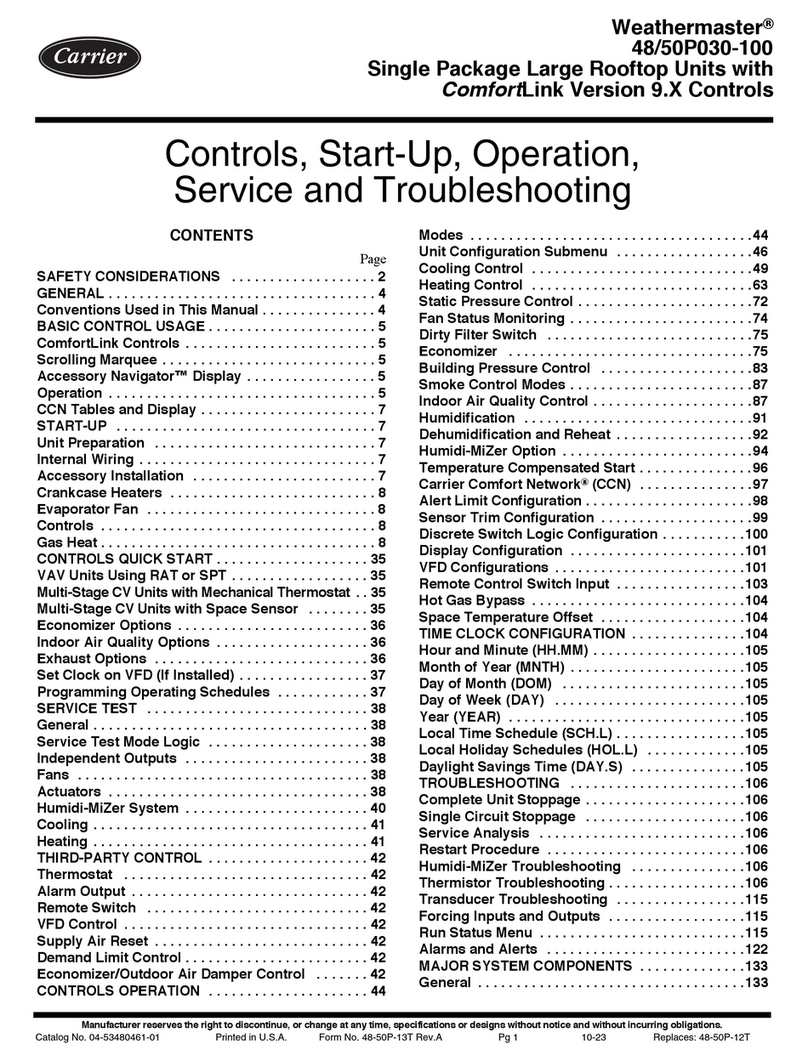
Carrier
Carrier Weathermaster 48P030-100 Controls, start-up, operation, service, and troubleshooting
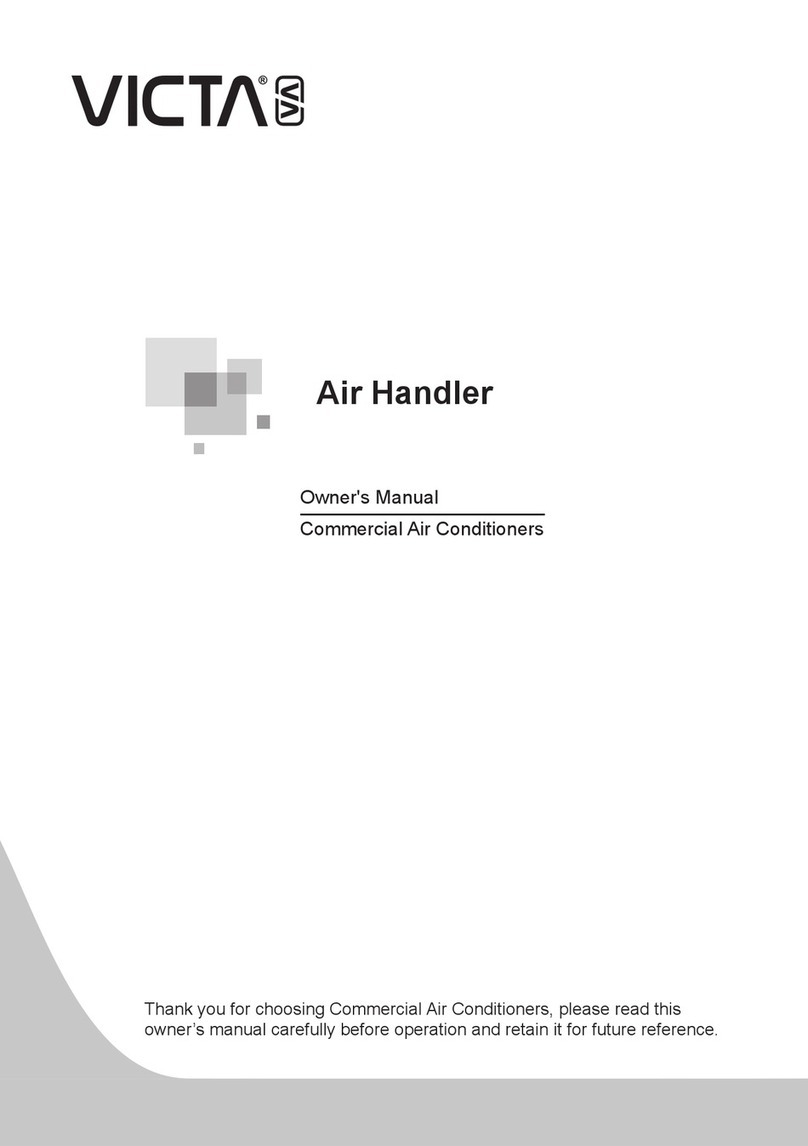
Vista
Vista VAF-36A308I owner's manual
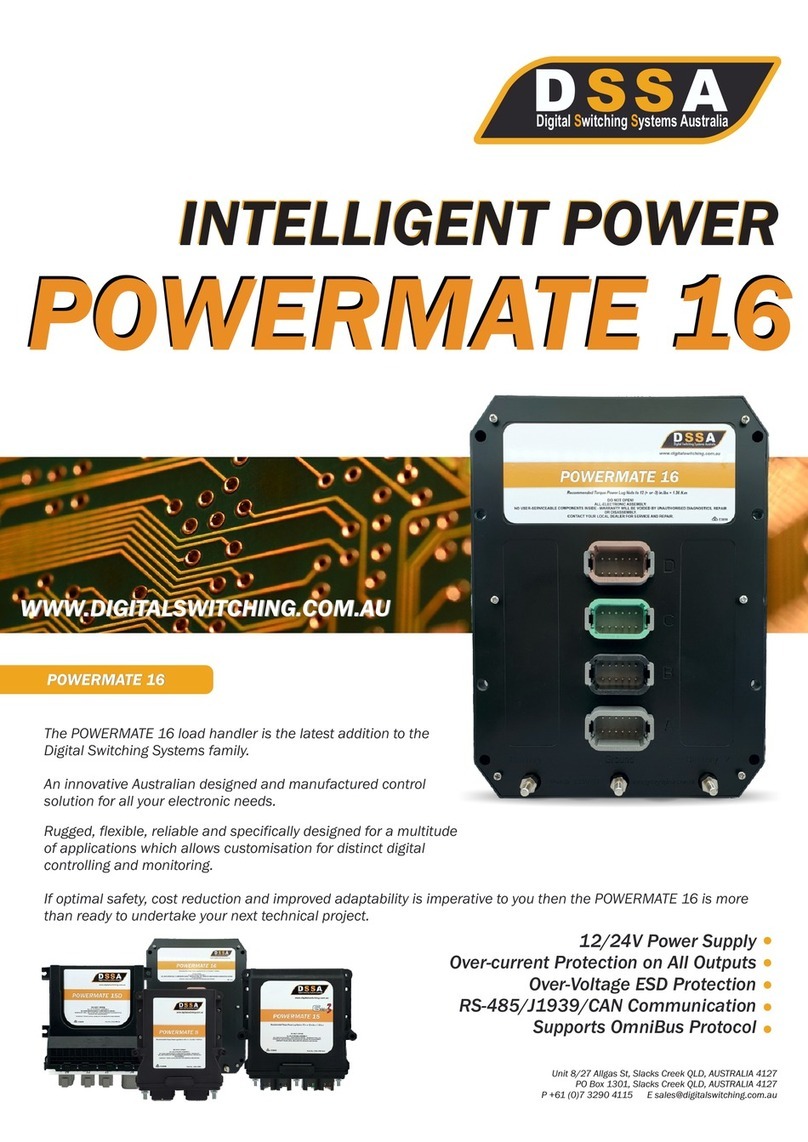
DSSA
DSSA POWERMATE 16 manual
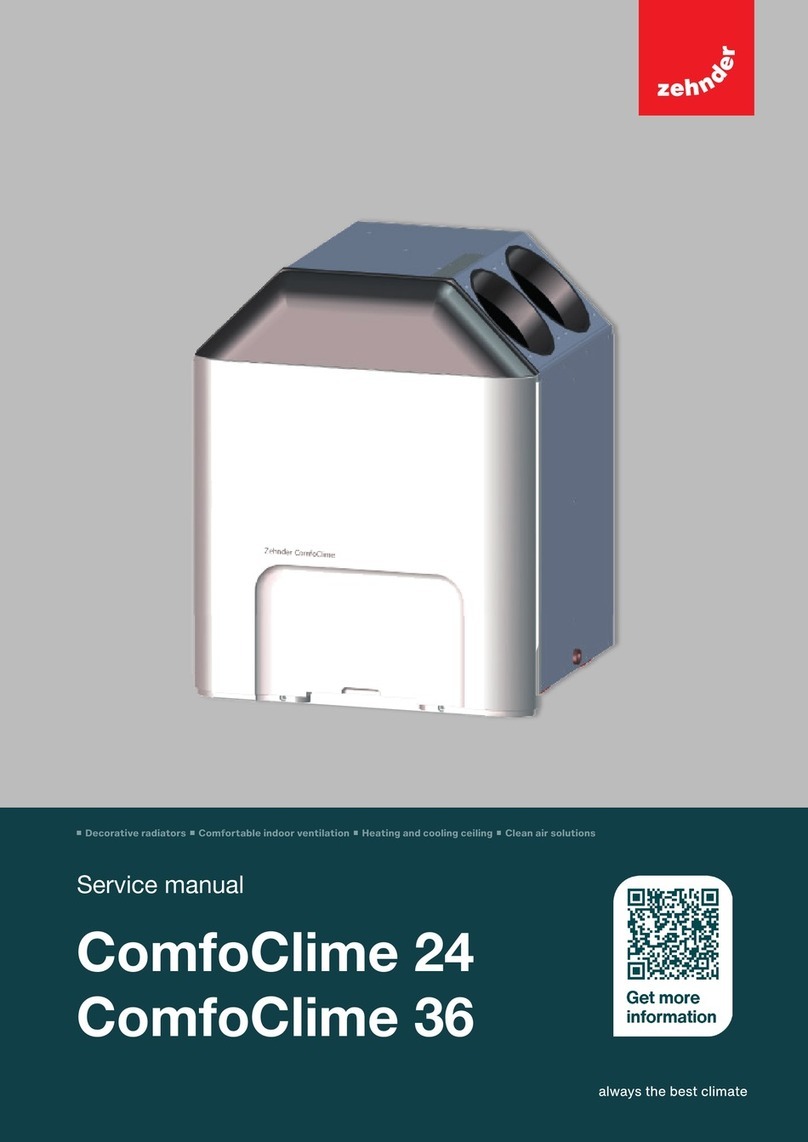
Zehnder Rittling
Zehnder Rittling ComfoClime 24 Service manual
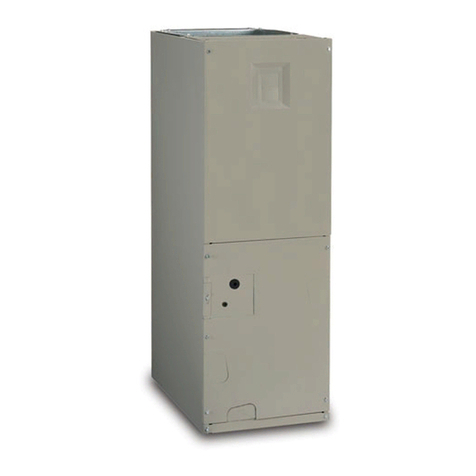
Maytag
Maytag B6BM series installation instructions
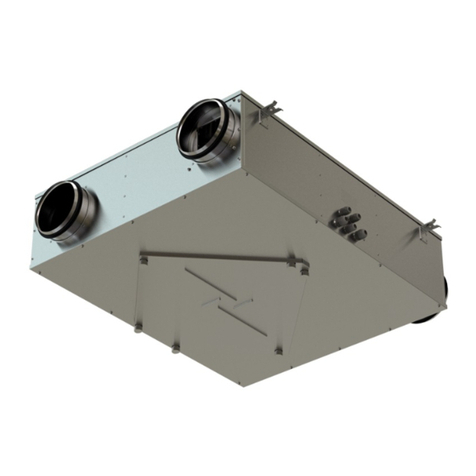
Vents
Vents VUE 100 P3 user manual
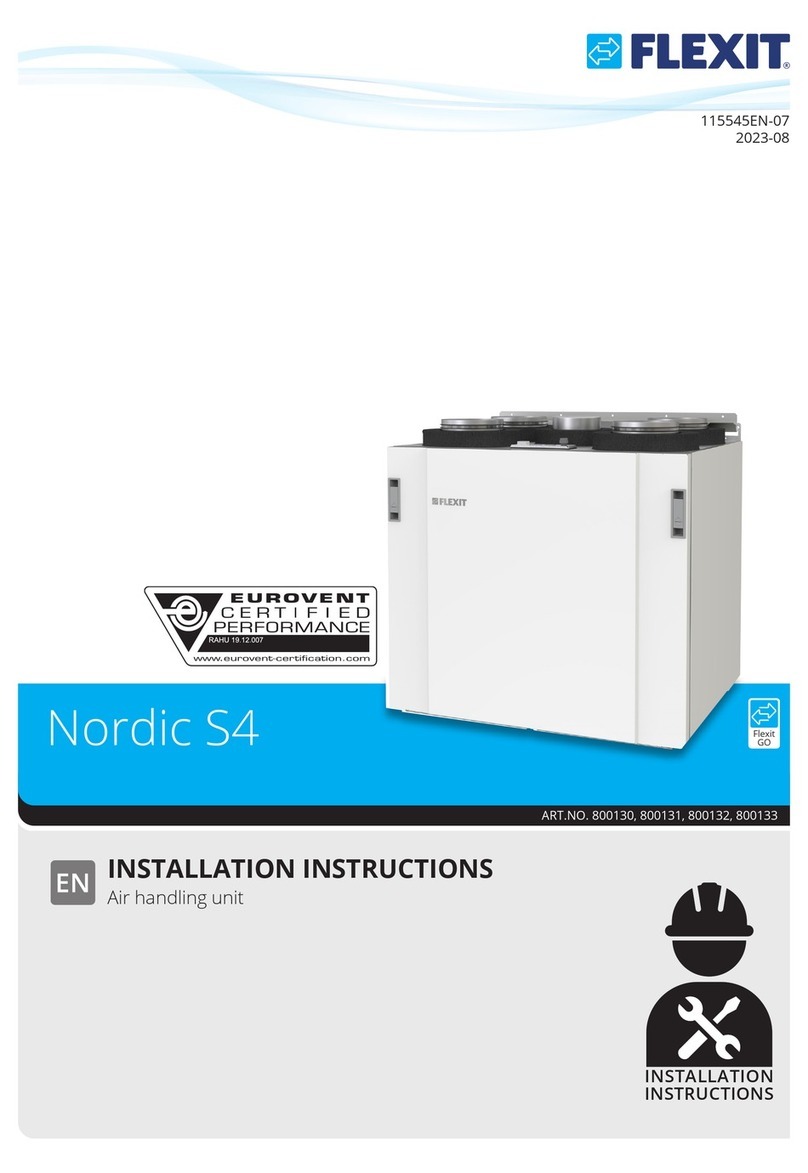
Flexit
Flexit Nordic S4 installation instructions
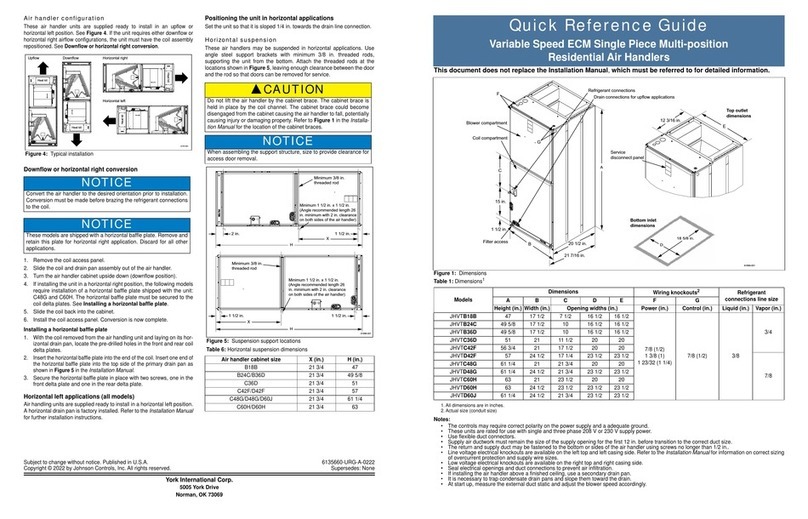
York
York JHVTB18B Quick reference guide

International comfort products
International comfort products FHS Series installation instructions
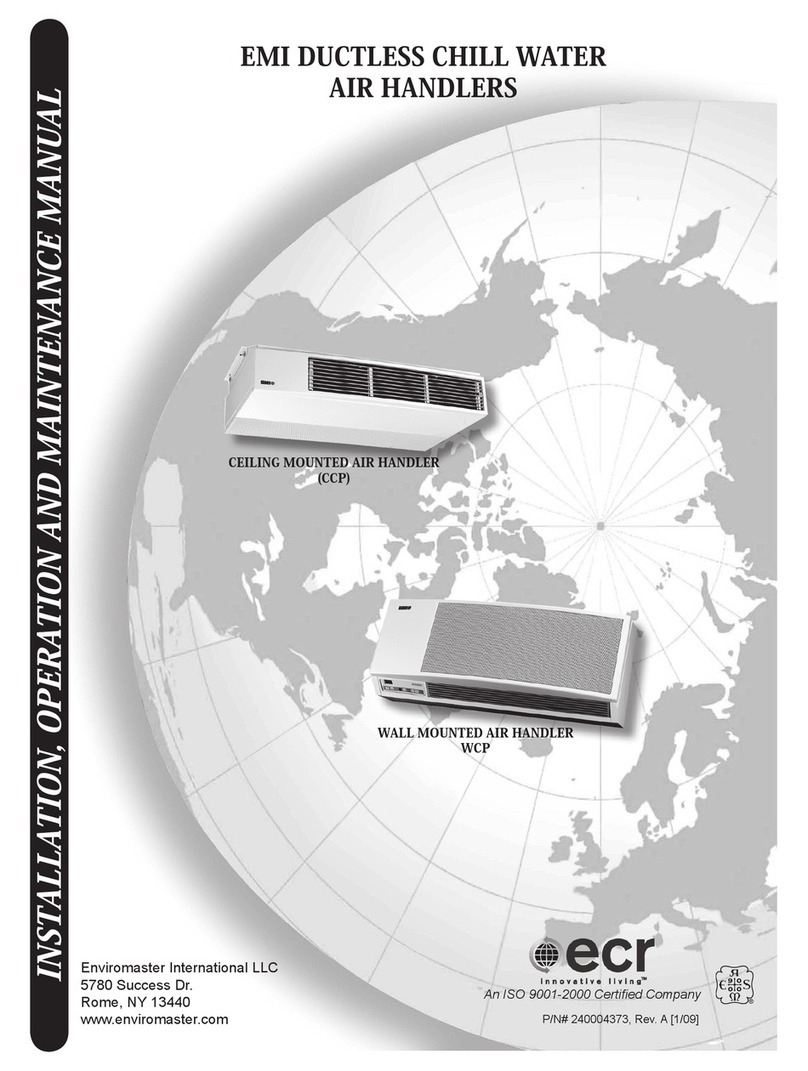
EMI
EMI ComfortWave WCP Series Installation, operation and maintenance manual
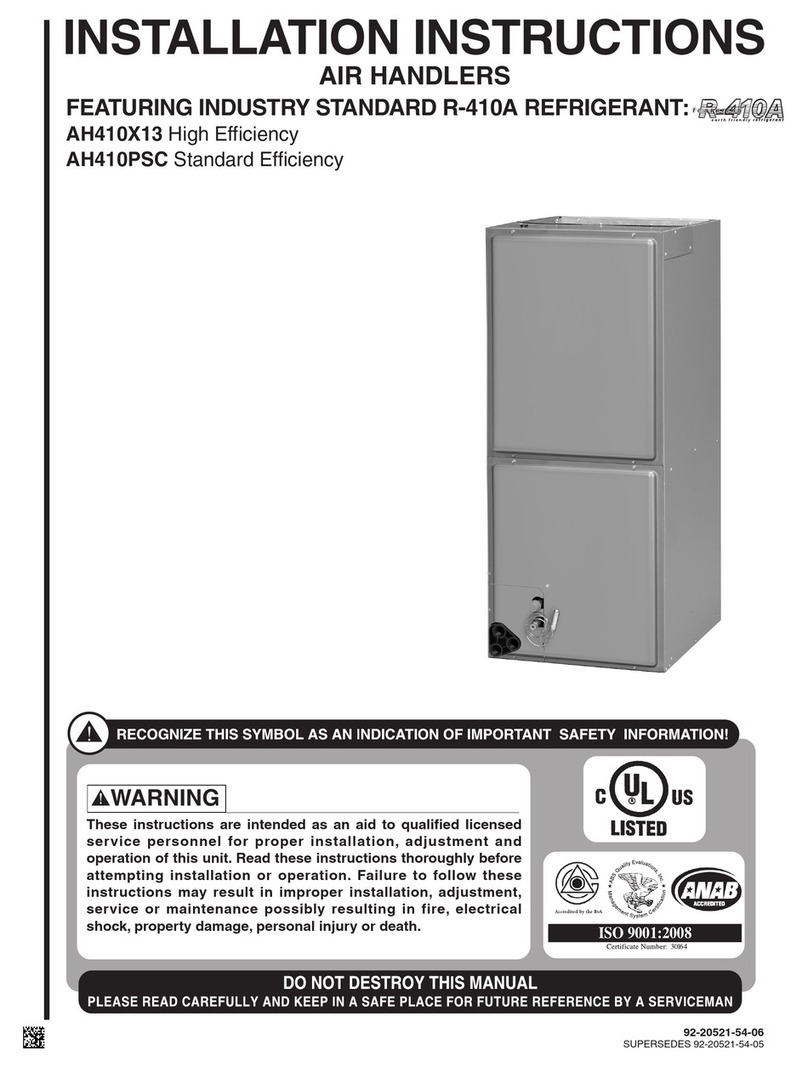
Sure Comfort
Sure Comfort AH410X13 installation instructions
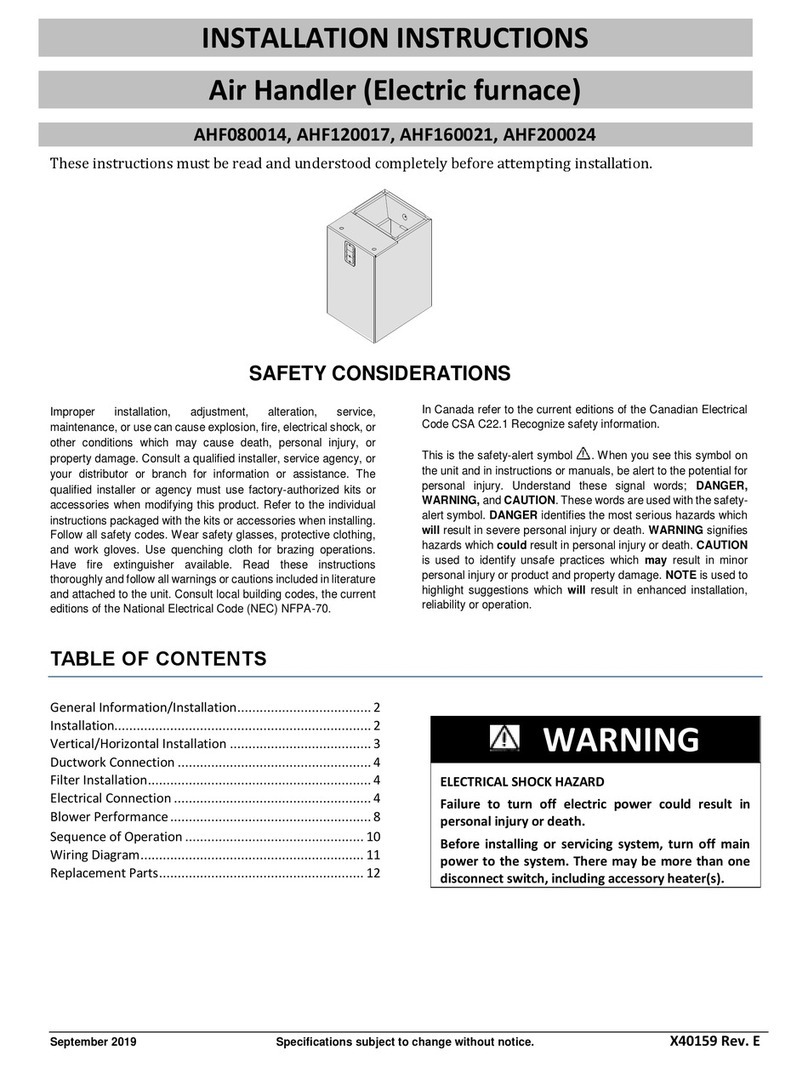
Dettson
Dettson AHF080014 installation instructions

